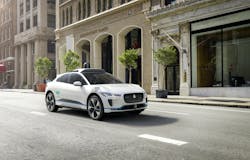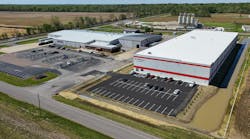Autonomous vehicles are a hotbed subject in our industry, as they should be. They potentially affect everyone, even non-drivers, and certainly tire dealers. To some, it is just the next step in the evolution of transportation.
And to others, a world of vehicles without drivers is just crazy talk! Heck, even in “The Jetzons” people were behind joysticks in their “flying cars.” (And there is such a thing as a flying car: Check out the Terrafugia Transition from Terrafugia Inc. at www.terrafugia.com.)
But it isn’t crazy talk, and autonomous vehicles are already in limited use. Both vehicle and tire manufacturers are investing a lot of money in research and development in preparation for their mass production.
The question everybody asks is, “When will they be more than a niche mode of transportation and ready for highway use?” Richard Smallwood, CEO and president of Sumitomo Rubber North America Inc., thinks it will be sooner rather than later. In his keynote speech at the 2017 Clemson University Global Tire Industry Conference, he cited a number of OEMs that have announced autonomous vehicle availability within the next five years.
Data from IHS Markit also supports his claim. “According to IHS, sales of autonomous cars, including driver control, will begin by 2025, and could reach 11.8 million in 2035,” said Smallwood. “Sometime after 2050, said IHS, almost all vehicles will be autonomous.”
Another popular question is, “Why do we need an autonomous vehicle?” The initial response is “to improve highway safety,” although the death of a woman killed by an autonomous Uber in Tempe, Ariz., last March may have set back widespread acceptance of autonomous vehicles.
There are additional obstacles standing in the way of their use. Mike Antich, editor of Modern Tire Dealer’s sister publication, Automotive Fleet, recently tackled that topic in his “Market Trends” column.
His perspective, of course, is centered on fleets. “Conceptually, autonomous vehicles are technologically feasible, but, as they say, the devil is in the details,” he wrote. “One thing is certain, as we trail blaze new ground, so too will we trail blaze new problems.”
Here is Antich’s list of 12 obstacles that need to be hurdled before the autonomous vehicle becomes commonplace among fleets. The list is just as thought-provoking for people in our industry.
Recognition of hand gestures. “Autonomous vehicles (AV) find it difficult to decipher the meaning of hand gestures by a driver or pedestrian giving it the right of way. Conversely, an AV runs the risk of misinterpreting a causal hand motion and erroneously determining it has been given the right of way. Understanding gestures is a major safety issue since it is used in a construction zone, by police officers directing traffic in an intersection with a disabled stop light, officers redirecting traffic around a vehicle accident, and at major public venues, such as concerts and sporting events.”
Difficulty driving in snow. “AVs are programed to recognize various road landmarks, such as lane dividers, turn only lanes, or when two lanes merge into a single lane. But when covered by snow, these road markings are obscured or hidden. Similarly, when snow or road grime covers vehicle sensors, it ‘blinds’ an AV to its surroundings impeding autonomous navigation.”
Driving through standing water or a flooded street. “Similar to the issues encountered when driving in snow, standing water likewise obscures road markings impeding AV travel.”
‘Autonomous vehicles will necessitate the creation of an entirely new body of case law,’ says Antich.
Inability of AVs to effectively communicate with human-controlled vehicles. “There will be a long transition period when AVs share the road with human-controlled vehicles. This will create a period of incongruity. For instance, a vehicle horn is used as a communication device providing a cautionary warning. Can an autonomous vehicle hear a horn? What about the colloquial rules of the road? For instance, will an AV know what is meant when a vehicle in the oncoming lane flashes its lights to yield to it the right of way? Flashing lights are also ambiguous because it can also signify displeasure. Can an AV distinguish between the two? What about ambulances and fire engines that in an emergency do not follow the rules of the road, such as driving through red lights? Ultimately, vehicle-to-vehicle technology will be embedded in emergency vehicles, but a fire truck can be in service for as long as 20 or more years before it is replaced.”
Decades needed to develop case. AVs will necessitate the creation of an entirely new body of case law that will take decades to adjudicate legal precedents. It is generally accepted that if an AV is forced to make a choice between hurting a single person versus many individuals, the AV will be programmed to take the course of least damage. (Based on current law), could a lawyer representing the aggrieved family argue premediated manslaughter — or even second degree murder — because the AV was programmed to intentionally hit a person? Unfortunately, the death of a pedestrian by an Uber AV won’t be the last person killed by an AV. What will be the reaction from regulatory agencies? Will reactions vary by state?”
Personal privacy concerns. “AVs will be tracked every moment of the day. As vehicle data is collected, so will data about the occupants, such as when and where they are driven. How will the privacy of vehicle occupants be protected?”
Higher acquisition costs. “AVs will be more expensive than the traditional driver-operated vehicle, which will impact a fleet’s total cost of ownership. What will be the residual value of a used AV? One way to look at it is to ask, ‘What is the value of your used personal computer?’ With the ability to download software updates, the ‘operating system’ of an AV will always be current, with obsolescence restricted to dated hardware.”
Taxing AVs. “If AVs strictly adhere to posted speed limits and parking restrictions, what will be the impact on government budgets from the subsequent reduction in traffic and parking fines? In a mid-size city, such as Seattle, traffic fines constitute 2.6% of the city’s operating fund. One idea floated by government officials is to mitigate this revenue loss by instituting an AV registration tax.”
Impact on organ donations. The No. 1 source of organ donations is young people who died in traffic accidents. With widespread AV usage, will there be a decrease in organ availability?”
Inadequacy of 5G network in an autonomous vehicle network. “Fifth generation wireless systems, abbreviated 5G, are improved networks that will deploy in 2019.
“Although 5G is very powerful, there are concerns widespread use of AVs will make it inadequate in providing robust communication.
“This will be a temporary concern, as technology will advance to address any inadequacy.”
Electromagnetic disruptions to GPS transmissions. “Solar storms are unpredictable and rare, but when they do occur, they erupt vast amounts of energy that can cause a massive spike in geomagnetic activity and radiation, which can interfere with the data connection between a vehicle’s onboard GPS system and the satellites that transmit location data. Electro-magnetic disruptions have caused flights to be diverted to alternate routes.”
Cybersecurity threats. “This is a real concern that will eventually result in deaths and triggers a pendulum reaction from regulatory and government agencies. Based on past history, cybersecurity is often reactionary and vulnerable to zero-day cyber-attacks.”
I found Antich’s additional comments on higher acquisition costs to be especially pertinent to our industry. In particular: “It is generally accepted that AVs will accumulate higher mileages since potentially they can be used in a 24/7 environment, which will have a direct influence on vehicle condition at the end of its service life.”
Many of his obstacles — the need for “an entirely new body of case law” really hits home to me — are reasons why I believe AVs will not be using our interstate highway system anytime soon. But one day they will. ■



